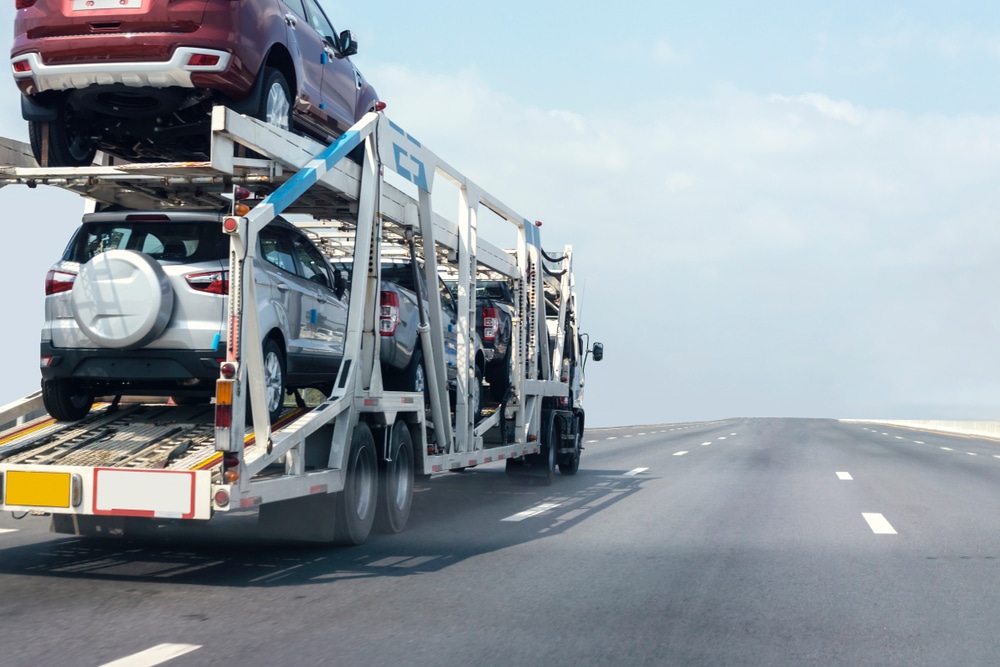- by admin
- Posted on June 22, 2022
A Guide to Shipping a Car With Personal Items
Car shipping is a highly convenient way to get your vehicle from point A to point B if you’re unable to drive it yourself for any reason.
This option can come in quite handy when you’re moving on a tight schedule or have several cars. Of course, car shipping services are widely available and can be arranged without much trouble. But that only goes for empty vehicles.
When you’re shipping a car with stuff in it, there are additional things to consider.
This article will give you a complete guide to shipping a car with personal items, including the necessary precautions and common mistakes to avoid.
Shipping a Car With Personal Items – An Overview
The first question that might come to mind is why would you transport personal belongings in your car. But the reason is pretty simple: You do that to save money and time.
The internet is full of useful moving advice and checklists, and you can quickly find “shipping car with stuff inside” as a section in many resources. And yes, it can be phrased just like that. Online resources aren’t always perfect.
All jokes aside, storing personal items in your car isn’t a bad choice when you’re moving. This is especially true if the items in question are small or too precious to be left inside a moving truck among other bigger belongings.
However, it’s one thing to move and drive your belongings yourself from the old home to the new one. In that situation, your car can be packed with your belongings up to the point where it interferes with driving.
But shipping your car with stuff inside is a completely different matter. You’re not handling the vehicle yourself. Instead, you’re transporting it in your car via a car shipping company that must adhere to particular guidelines.
When packing your car with your belongings for transport by a car shipping company, certain items are allowed while others are prohibited. Restricted items include explosives, flammable material, and dangerous chemicals. Firearms can be transported, but under special conditions (unloaded, locked in a case, and away from people in the vehicle), though laws vary by state.
These restrictions are particularly important when shipping. A shipping company definitely won’t take on the risk of transporting items that have no place in a private vehicle.
Weight will also be an important point of consideration. Regulations around car shipping weight are very strict, so shipping a car full of stuff will likely be impossible. Plus, additional weight can subject your vehicle to extra fees from some shipping companies.
These are just some of the things to keep in mind when shipping your car. Let’s explore the essential matters in more detail.
What Items Can and Can’t Go Into Your Car
Luckily, shipping a car with personal items comes with an entire list of things that car transporters commonly accept.
First, items made of fabric or similar, softer materials will usually present no issues. You can pack shoes, clothing, bedding, and linens without worry. This might be good news for many since clothing and similar items can take up considerable space in transport. You might be able to save yourself another trip by putting your bedding, shoes, and clothes inside your trunk.
Similarly, books are most often not an issue. However, avid readers might find transporting their collection in a shipped car more expensive due to weight. Books can get surprisingly heavy when in a large pile, with three 150-page books clocking in at a bit more than 2 pounds.
In other words, if you intend to pack a small library in your car for shipping, you might go over the weight threshold sooner than expected.
Continuing with the list of allowed items, most companies won’t have a problem with smaller ornamental and furniture pieces. Of course, weight could become an issue here as well, but you’ll need to consider something else, too.
Particularly delicate items can get damaged during regular transport, let alone when left in a car that’s being shipped on the back of a truck. For that reason, it would be best to ensure that ornamental pieces are secured properly. But bear in mind that the packaging itself has some weight as well.
In addition to the aforementioned items, car transport with personal items is possible for most other belongings that remain under the weight limit and are not prohibited by the law.
There aren’t a lot of items that fall under the forbidden category when it comes to car shipping. First, you likely won’t be able to ship any overly heavy or large objects inside your car. Such items can create a road hazard and most companies wouldn’t accept them in any case. There’s also the question of your car’s safety. An oversized item can easily damage the interior or even break a window if it’s jostled while on the road.
Next, perishable food and plants are off the table. Such items could spoil during transport, spreading unsavory odors and leaving waste. Besides, there are much better options for food transfer, and a potted plant likely wouldn’t handle the journey very well anyway.
Finally, it’s expressly forbidden to transport dangerous matter in your car when shipping it. As we mentioned, the list of prohibited materials includes radioactive, poisonous, explosive, and flammable items. Of course, it also extends to weapons, as well as other illegal items.
Federal regulations prohibit or restrict the transport of such items in vehicles also carrying passengers. This means it’s likely that a shipping company won’t be too keen on transporting a potentially lethal load either.
To put it simply: Can you ship car with stuff in it? Sure. Can you pack it with explosives and uranium? Not a chance.
To reiterate, even interstate car transport with personal items is possible, but only if those items are of the right kind and up to a certain weight.
The Question of Weight
Car shipping companies keep track of weight for several reasons.
First, the truck carrying your car has a weight limit itself. Going over that maximum load capacity could create unsafe driving conditions and expose the company to potential penalties. All haulers have regular weight checks when on the road. If weigh station officials determine the truck is overweight due to an excessively packed car on it, they might remove items adding to the weight and offload the vehicle in question at the station.
Naturally, something like this would complicate matters for you and the company.
Next, there’s the issue of fuel consumption. More weight creates more drag, causing the truck to spend extra fuel per mile. If every car on the carrier was filled to the brim, the transport job could prove less profitable, especially on longer trips.
By now, you’ve realized that it’s not a question of whether can you put stuff in the car when shipping. Rather, it’s a matter of what kind of stuff it is and how much it weighs.
Speaking of weight, it would be best to understand certain key terms that shipping companies and federal regulations consider.
In particular, you should know the difference between two terms that might’ve popped up in your research: GVM and GVWR. Both relate to weight and can be crucial when shipping a car with personal items.
GVM, or gross vehicle mass, expresses the total weight of a vehicle. This metric is subject to change as it includes more factors than just the vehicle itself. For instance, the weight of your car could be expressed as curb weight, which doesn’t take any occupants or cargo into account. Or, it could be shown as dry weight, which is the car’s weight without fuel, oil, or other consumables.
On the other hand, GVWR is the maximum of a vehicle’s operating mass. Weight limitations apply to this metric, not GVM. The acronym stands for gross vehicle weight rating, and it accounts for passengers, cargo, and additional accessories. Shipping companies will check the GVWR for your vehicle by searching for the determined value for the exact make, model, and year.
Meanwhile, a truck’s maximum load capacity is calculated as the difference between the vehicle’s GVWR and curb weight.
Now the question might become: When shipping a car, can you pack it to the maximum load capacity?
The answer is most likely no.
Remember, a shipping truck doesn’t haul one or two vehicles. A typical carrier can transport up to eight or nine cars and has a load capacity limit of 80,000 pounds. For that reason, most companies will allow a maximum of 100 pounds packed inside a car.
Some companies might allow additional weight free of charge, while others might ask for a fee of over $200.
Potential Risks of Shipping a Car With Personal Items
Even if you comply with all federal and company-specific guidelines and rules, that doesn’t mean all aspects of shipping are covered. There are two particularly important additional considerations.
The first is potential damage. When you’re shipping your car, the vehicle itself is covered by insurance against damages. However, the same doesn’t apply to car transport with goods inside.
Car insurance won’t cover any items you load into the car. This means that packaging and loading will be crucial. Furthermore, you’ll want to pay attention to where you put your stuff in the car.
If you’re wondering, can you put things in your trunk when shipping your car? The answer is that not only can you do that, but you absolutely should. You likely won’t be able to secure items properly inside the cabin and prevent them from tumbling around.
If packaged properly, your belongings will have a better chance of getting through the journey in the trunk. But avoiding damage isn’t the only reason why you should keep your items out of the cabin.
The other reason is the risk of theft, which is also the second important thing to consider.
It should go without saying that a respectable car shipping company will put certain measures in place to provide the safest transportation possible. Still, even with the tightest measures applied, you can never be 100% sure that an opportunistic thief won’t attempt to break into your car.
And even if they don’t succeed and are left empty-handed, the vehicle might be damaged in the attempt.
There’s an easy way to reduce the chances of something like this happening: by giving potential thieves less incentive to even try.
The first thing you can do to lessen the risk is choosing carefully which items are left in the vehicle. If you have belongings of high value, you won’t want to leave them exposed. Naturally, this applies to both financially and sentimentally valuable things.
In addition, those belongings that you end up shipping with your car shouldn’t be visible through a window. Ideally, you’ll want to tuck them away safely in the trunk.
Prepare Thoroughly and Ship Away
So, when you ship a car, does it have to be empty? Not at all – you can pack various items inside, within reason.
But can you ship a car full of stuff? Most likely not a chance unless the stuff in question is paper tissues.
If you need to pack personal items into your car when shipping, it’s best to do your due diligence beforehand. Make sure to understand which items are allowed, what additional weight your company of choice will accept, and how you’ll store the goods for transport.
Speaking of shipping companies, you’ll want to find the best possible option on the market.
In that case, Cross Country Car Shipping might be just what you’re looking for.
Contact us via this link, and let’s transport your car on the road safely.





